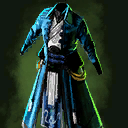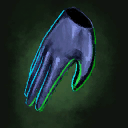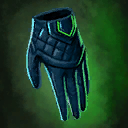User:Masel/DPSBuildGuideLines
Introduction[edit]
Guild Wars 2 offers two main playstyles to deal damage; Strike damage and Condition damage. There are some builds that make use of equal shares of both, but most builds focus on one of them. This holds true for both full dps builds and Boon dps builds.
Boon dps builds are a mix between a support role and a full dps build, since they sacrifice some of their damage to be able to provide one of two essential boons: Quickness or Alacrity. On top of that, they're there to supply additional boons that a healer might not be able to provide. The great thing is that every Profession has at least one Power-DPS, one Condition Damage-DPS, one Alacrity-DPS and one Quickness-DPS build that are viable for instanced content (keep in mind that viable is not equal to competitive). So regardless of the Profession you chose, you will be able to fulfil all damage-focused roles!
Before we start, I want to point you to trustworthy sources for builds (aside from mine of course!):
- Snowcrows - This is the go-to hub for fully optimized rotations, also called benchmarks. I simplify the rotations to make them more digestible, at the cost of a few % of damage. Which source is better for you depends on the time you want to put in to learn a rotation and your skill level in general.
- Metabattle - The folks from metabattle work hard to supply builds for all game modes, including open world PvE. Their builds are awesome and they often have builds I don't have (and vice-versa :P) . They share the same build philosophy as I do, so make sure to check them out!
The following sections are meant to prepare you for your journey in Group PvE in Guild Wars 2 by covering the following topics:
- Build Basics & Damage Calculation
- Getting Cheap Starter Gear off the Trading Post
- Special Forces Training Area Preparation
Power Build Basics & Damage Calculation[edit]
If you want to dive into instanced content, it's important that you know how your build works. Power builds focus on Strike damage, which usally entails higher burst damage, as it is inflicted directly. That makes Power builds very suitable for burst-friendly encounters with smaller mobs and shorter phase times.That doesn't mean that the sustained damage of power builds is low; it just means that they can inflict more damage over shorter timeframes. Then, they often wait for their cooldowns to come back to repeat the burst cycle. That playstyle gives Power builds a typical wave-shaped damage graph, moreso than Condition Damage builds.
Interaction of Power, Precision and Ferocity[edit]
Another part of understanding the choices for gear, traits and skills lies in the stat power they provide. Power builds mainly utilize three stats: Power, Precision and Ferocity:
- Power has a base value of 1000 and increases the base damage of your skills. How large the impact of Power on your damage is depends on the scaling coefficients of the skills you use.
- Precision adds 1% to your Critical chance for every 21 points you have of it. Critical chance has a base value of 1000 and starts at 5%. Aside from Precision, there are flat %-modifiers: a prominent example would be the Boon Fury.
- Ferocity adds 1% to your Critical damage for every 15 points you have of it. Critical damage has a base value of 150%. Akin to Precision, there are %-modifiers to Critical damage. These are multiplicative to your Critical damage.
- There are additional %-damage done & taken modifiers that affect all Power damage. Damage done multipliers can be additive or multiplicative, damage taken multipliers are all multiplicative (as one could easily reduce damage to 0 otherwise). The damage done modifiers are on the player (e.g. Relic of the Thief), the damage taken modifiers are applied to the target ((e.g. Vulnerability). A full list of all damage modifiers can be found on the Damage Page.
A simplified formula to calculate your average damage would look like this:
Average Strike Damage Formula
| Damage Component | Formula |
|---|---|
| Base Damage | Power * Average Weapon Strength * Scaling Coefficient / Target's Armor |
| * General Modifiers | * (1 + Sum of Add. % Damage Done Modifiers) * (1 + Mult. % Damage Done Modifier 1) * (1 + Mult. % Damage Done Modifier 2) * ... * Total Target Damage Taken Modifier |
| * (1 + Critical Chance * (Critical Damage - 1)) | * (1 + Min (5% + ( Precision - 1000) / 2100 + Sum of % Critical Chance Modifiers , 100%) * ((150% + Ferocity / 1500) * (1 + Mult. % Critical damage Modifier 1) * (1 + Mult. % Critical damage Modifier 2) * ... ) - 1) |
Maximizing your average damage thus means maximizing this formula within the constraints given by the game. This might seem complicated, but the implications drawn are quite simple:
- the impact of Power on your damage is linear and neither depends on Precision nor on Ferocity,
- damage gains from Precision and Ferocity are mutually dependent. The more Critical damage you have, the more beneficial an increase in Critical chance will become and vice-versa.
- Power builds usually have a lot of Ferocity built in, which makes Precision the number 1 priority for power builds. For obvious reasons, it is capped at 100% (Critical chance is a probability, and probabilities cannot exceed 100%).
DPS Build Tenet 1 Precision first. Make sure to reach 100% Critical chance on Power builds!
After reaching 100% Critical chance, the break-even point between Power and Ferocity varies per build and the calculation of the breakpoints is quite cumbersome. The difference is minor and often not statistically significant in actual gameplay, so don't worry about that for now.
Weapon Strength[edit]
If you paid attention to the formula for damage, you recognized that Weapon Strength is a part of it and linearly increases your damage just like Power does. It is also responsible for the variance in Power damage, as the damage for each hit is randomly taken from a fixed range that varies for each weapon. Most importantly, the item quality increases your weapon strength, so that having Ascended weapons is priority number 1 on Power builds over the other gear pieces. As we will see later, it does not affect Condition Damage at all, making it (almost) negligible on Condition Damage builds.
Here's an example using a greatsword on various qualities (Legendary is equal to Ascended stat-wise):
| Weapon Quality | Minimum | Midpoint | Maximum | % Increase of Midpoint |
|---|---|---|---|---|
| Rare | 882 | 929 | 975 | |
| Exotic | 995 | 1048 | 1100 | 12.8% |
| Ascended | 1045 | 1100 | 1155 | 5.0% |
So on average, replacing your Exotic weapon with an Ascended one will increase your damage by up to 5%, simply via the increased Weapon Strength. The "up to 5%" is important there, as non-weapon skill sets use their own weapon strengths, some of which are shared with weapons while others are unique. This includes Kits, Bundles, Conjures, Healing Skills, Utility Skills, Trait skills, Elite skills et cetera. So the actual increase will be lower than 5%, but still noticeable.
DPS Build Tenet 2 Weapons First on Power builds. Getting Ascended Weapons will increase your damage noticeably just via the increase in Weapon Strength!
Condition Damage Build Basics & Damage Calculation[edit]
The second DPS build type you can go for are Condition Damage builds. These apply damaging Conditions in larger amounts, dealing damage over time. In turn, they have a tendency for a slower damage ramp-up compared to Power builds, but more consistent damage per second. Nonetheless, they can still accumulate high damage quickly with the right build and always retain a smaller share of Power damage. Condition Damage builds excel at encounters where you have dps downtimes, as the conditions will keep ticking their damage once per second for a while even when dealing with mechanics, roleplaying as a Choya or using the Bobblehead Laboratory.That also makes them excellent picks for solo gameplay in open world; more details on that in the other write-up.
Condition Damage builds mainly utilize two stats: Condition Damage (duh) and Expertise.
- Condition Damage increases the damage per tick of conditions and
- Expertise adds 1% to Condition duration for every 15 points you have. This caps out at 100%, doubling the duration.
- Just like for Power damage, there are additional %-damage done modifiers that affect Condition Damage. In this case, any modifier that affects one particular condition is multiplicative with general Condition Damage done modifiers. A full list of all damage modifiers can be found on the Damage Page.
- On top of the damage modifiers, there are also condition-specific duration modifiers. Duration modifiers are all additive, but there are modifiers that increase the base duration of particular skills, such as Chemical Rounds or Lingering Curse. These are then affected by duration increases normally.
- Most condition builds also benefit from a decent amount of Critical chance (and thus Precision), as they include traits or sigils that trigger on Critical hits:
- Sharpened Edges on
 Ranger - Bleeding (33% Chance)
Ranger - Bleeding (33% Chance) - Burning Precision on
 Elementalist - Burning (33% Chance)
Elementalist - Burning (33% Chance) - Arcane Precision on
 Elementalist - Burning or Bleeding (33% Chance)
Elementalist - Burning or Bleeding (33% Chance) - Sharper Images on
 Mesmer - Bleeding (100% Chance for Illusions)
Mesmer - Bleeding (100% Chance for Illusions) - Jagged Mind on
 Virtuoso - Bleeding (100% Chance on Blades)
Virtuoso - Bleeding (100% Chance on Blades) - Bloodlust on
 Warrior - Bleeding (33% Chance)
Warrior - Bleeding (33% Chance) - Furious on
 Warrior - 15 Condition Damage (Max. 25 Stacks)
Warrior - 15 Condition Damage (Max. 25 Stacks) - King of Fires on
 Berserker - Burning (on Fire Aura detonation)
Berserker - Burning (on Fire Aura detonation) - Sharpshooter on
 Engineer - Bleeding (33% Chance)
Engineer - Bleeding (33% Chance) - Incendiary Powder on
 Engineer - Burning (33% Chance)
Engineer - Burning (33% Chance) - Barbed Precision on
 Necromancer - Bleeding (33% Chance)
Necromancer - Bleeding (33% Chance) - Superior Sigil of Earth Bleeding (100% Chance)
- Superior Sigil of Torment Torment (100% Chance)
- Sharpened Edges on
In order to understand the choices made for gear, skills and traits on particular builds, let's have a look a the calculation for total damage dealt by conditions. This formula is the same in structure for all damaging conditions, just with varying inputs per condition for base damage, scaling coefficient and modifiers for damage and duration:
Total Condition Damage Formula
| Damage Component | Formula |
|---|---|
| Condition Damage per Second | Condition Damage * Scaling Coefficient + Base Damage |
| * General Modifiers | * (1 + Condition-Specific % Damage Done Modifier) * (1 + Sum of General % Condition Damage Done Modifiers) * Total Target Damage Taken Modifier |
| * Duration in Seconds | * Base Duration in Seconds * (1 + Min ( Expertise / 1500 + Sum of % Condition Duration Modifiers , 100%)) |
If you want to maximize your damage, maximize this formula. For condition builds, things become a bit more complex, as they usually include a mix of several conditions. In turn, you have multiple instances of the formula running simultaneously. Luckily, the main implications drawn from this are quite simple:
- Both Condition Damage and Expertise linearly increase the total damage dealt by a condition.
- The breakpoint between Condition Damage and Expertise depends on the scaling coefficent, base damage and the condition duration modifiers for the respective condition. For a detailed calculation of the breakpoints, see here.
- Condition builds care less about Weapon Strength, as it only affects the small share of Power damage they deal. Since some Condition Damage builds have larger shares of Power damage (up to 25%), it still matters, just way less. Using Exotic Weapons is thus not a big deal on them.
Here's a list of the the base damage, scaling coefficients and breakpoints for each condition:
| Condition | Formula | Inflicted | Condition Damage / Expertise Breakpoint |
|---|---|---|---|
| Bleeding | 0.06 * Condition Damage + 22
|
per second | 1133 |
| Burning | 0.155 * Condition Damage + 131
|
per second | 655 |
| Poisoned | 0.06 * Condition Damage + 33.5
|
per second | 942 |
| Torment | 0.06 * Condition Damage + 22
|
per second (moving foe) | 1133 |
| Torment | 0.09 * Condition Damage + 31.8
|
per second (stationary foe) | 1146 |
| Confusion | 0.035 * Condition Damage + 10
|
per second | 1135 |
| Confusion | 0.0625 * Condition Damage + 49.5
|
per foe skill use | 997 |
The breakpoints for most conditions are quite low, meaning that most builds will bypass them easily (25 stacks of Might alone provide 750 Condition Damage). For that reason, you will usually prioritze reaching 100% condition duration on the important conditions. After that, any additional condition duration modifiers or point of Expertise is wasted.
; DPS Build Tenet 3 : Condition Duration First! Prior to maximizing Condition Damage, it is usually ideal to go for Condition duration modifiers (like Expertise).
But which conditions should your build prioritize? A good indicator are the amplifications for ![]() Condition Damage and
Condition Damage and ![]() Condition Duration per Profession. These typically conincide with Weapon, Trait and Skill options that apply the boosted conditions.
Condition Duration per Profession. These typically conincide with Weapon, Trait and Skill options that apply the boosted conditions.
; DPS Build Tenet 4 : When a Profession or Elite Specialization includes damage or duration modifiers for particular conditions, there usually are Endgame DPS builds making use of them.
Here's a table with the modifiers per Profession and general modifiers embedded in Sigils:
Condition-Specific Damage (![]() ) and Duration (
) and Duration (![]() ) Modifiers
) Modifiers
| Profession | Bleeding | Burning | Confusion | Poisoned | Torment | General |
|---|---|---|---|---|---|---|
| Sigils |
Getting Starter Gear[edit]
If you're looking to gear up a new character for instanced PvE, the first hurdle to take is to get gear that is somewhat useful there, but doesn't cost you a fortune. Getting Ascended gear always takes a bit of time AND/OR lots of money to acquire, so you won't be able to get it right away after reaching level 80. Fortunately, the difference in stats between Exotic and Ascended is not that large:
- Note 1: This image is as of June 2023, but the general tendency doesn't change!
You'll notice that Condition Damage builds lose less damage compared to Power builds here, which is the logical consequence of the impact of Weapon Strength. The gap becomes smaller once you use Ascended weapons on the Power builds.
DPS Build Tenet 5 Using Exotic gear is fine for all content aside from High-Tier Fractals (and that only doesn't work because of Agony Resistance).
In the following sections, I'd like to show you good enough gearing options that are very cheap and purchaseable from the Trading Post, so you don't have to wait to get it. I'll guide you through this for both Power and Condition Damage builds seperately, as gearing them is fundamentally different. In any case, using starter gear is completely fine for all instanced content aside from higher-tier Fractals of the Mists or Challenge Mote Raids/Strike Missions.
My recommendation is to...
- get Starter Gear as listed below,
- unlock your Elite of choice with it and
- start farming Ascended gear with that, in various content types (Open World, Fractals of the Mists, Strike Missions and/or Raids). For more details on the easy options for that, take a look at Tanetris' Extensive Gearing Guide.
Along the way, make use of any useful gear piece you acquire to improve your Build!
If you're playing a Boon DPS Build, you often include some Concentration to maintain either Quickness or Alacrity reliably. The budget gear for Condition Damage builds includes Concentration by default through the Ritualist's Prefix.
Starter Gear for Power Builds[edit]
- As mentioned above, the three stats that matter for Power builds are Power, Precision and Ferocity (with added Concentration for Boon DPS builds). There are seven Prefixes that include all three: Berserker's, Grieving, Diviner's, Dragon's, Demolisher's, Marauder's and Celestial (Major Stats in bold).
Possible Prefixes for Power Builds
| Prefix | Stats (Relative to a Major 3-stat Attribute) |
Total Power Stats (Sum of Percentages) |
Total Offensive Stats (Sum of Percentages) |
Total Stats (Sum of Percentages) |
|---|---|---|---|---|
| Berserker's | 100 % Power 71.31 % Precision 71.31 % Ferocity |
242.63 % | 242.63 % | 242.63 % |
| Assassin's | 71.31 % Power 100 % Precision 71.31 % Ferocity |
242.63 % | 242.63 % | 242.63 % |
| Dragon's | 85.66 % Power 47.01 % Precision 85.66 % Ferocity 47.01 % Vitality |
218.33 % | 218.33 % | 265.34 % |
| Diviner's | 85.66 % Power 47.01 % Precision 47.01 % Ferocity 85.66 % Concentration |
179.68 % | 179.68 % | 265.34 % |
| Marauder's | 85.66 % Power 85.66 % Precision 47.01 % Ferocity 47.01 % Vitality |
218.33 % | 218.33 % | 265.34 % |
| Demolisher's | 85.66 % Power 85.66 % Precision 47.01 % Ferocity 47.01 % Toughness |
218.33 % | 218.33 % | 265.34 % |
| Grieving | 85.66 % Power 47.01 % Precision 47.01 % Ferocity 85.66 % Condition Damage |
179.68 % | 265.34 % | 265.34 % |
| Celestial | 47.01 % Power 47.01 % Precision 47.01 % Ferocity 47.01 % Condition Damage 47.01 % Expertise 47.01 % Concentration 47.01 % Healing Power 47.01 % Vitality 47.01 % Toughness |
141.04 % | 235.06% | 423.11 % |
The largest stat density for Power builds comes from using Berserker's or Assassin's, as they are a 3-stat Prefixes that do not trade a share of one of the three stats for a fourth stat. Assassin's is used on builds that do not reach the Critical chance-cap to trade Power for Ferocity 1-to-1. Since Grieving is a Prefix that's mainly used on Condition-based damage builds, we're not going to discuss it further here. Marauder's, Demolisher's and Celestial are a dps loss compared to other options and fairly expensive, so I would not recommend using them on Power builds. Dragon's and Diviner's have fairly clear purposes in PvE:
- Dragon's is used on builds that natively reach more than 100% critical chance with a full set of Berserker's to gain free Vitality. It has cheap Weapons.
- Diviner's is the best way to obtain additional Concentration on Power builds, as it does not have a 1-to-1 trade-off in stat (unlike using Concentration Food or Utility items). The Exotic Trinkets are relatively cheap to buy.
Power Armor, Trinkets and Weapons[edit]
When you want to replicate a PvE build, you can simply replace the Ascended pieces it uses 1-to-1 with Exotic. That usually leads to a loss in stats, as described above. Since Precision is a) the mathematically superior stat and b) [[Critical chance] below 100% can have mechanical downsides, making up for the difference (usually around 3%) is usually the first priority. The following table shows prices for Exotic gear for the Prefixes listed above aside from Celestial. There are a few main takeaways:
- The Trinkets for Power builds all cost roughly the same and are reasonably cheap. Since it is also the most stat-efficient option, Diviner trinkets are a great way to obtain additional Concentration
- Assassin's trinkets and weapons can be used to obtain additional Precision.
- Any Power prefix for armor except for Berserker's is quite expensive. You should therefore prioritize other options if you want to change Prefixes.
- The Backpack in Exotic is very expensive given its low stat density, so I don't recommend buying it. Instead, take a look at Crafter's backpacks, which are very cheap, allow you to select Berserker's stats and put a Ruby Orb on them. Leveling Chef to 400 costs less than one purchaseable backpack ( See this link for a quick guide on it.
Prices for Power Gear
Power Runes & Sigils[edit]
In terms of upgrades, Runes make up for a significant portion of your damage stats. The maximum amount of stats you gain from them on Power builds is 400, which is roughly equal to what an Ascended Amulet gives you! The following table shows the useful upgrade options for Power builds. The main takeaways are:
- Given that most builds reach 100% Critical chance without additional Precision from runes, the two main runes for damage grant Power and Ferocity. These rune are, unfortunately, very expensive to get.
- If you dont want to spend that much gold for your Exotic gear set, Superior Rune of Rage is 100 stats below those options, which isn't too big of a damage loss (between 2-3%).
- For builds that need additional Precision, Superior Rune of the Eagle is the cheapest option you can go for. Since you can calibrate any build to reach 100% Critical chance with any of the runes that include Precision, simply go for the one that is cheapest to obtain. They are close to identical in terms of damage output (we're speaking of a fraction of 1%).
- For the poorest of the poor, Chunk of Pure Jade gives around 3% Critical chance and ~150 lower stats comapred to runes, which is around what you need to compensate the difference between Ascended and Exotic.
Prices for Power Upgrade Components
| Rune | Price for 6 Pieces | Power | Precision | Ferocity | Vitality | Effective Damage Stats | Notes |
|---|---|---|---|---|---|---|---|
| Superior Rune of the Scholar | … | 175 | 0 | 225 | 0 | 400 | Ideal damage rune for builds with high innate Ferocity relative to Power. Examples: |
| Superior Rune of the Dragonhunter | … | 100 | 0 | 300 | 0 | 400 | Ideal damage rune for builds with high innate Power relative to Ferocity. Examples: |
| Superior Rune of Infiltration | … | 175 | 225 | 0 | 0 | 400 | Damage runes for some builds with low innate Precision. Examples: |
| Superior Rune of the Ranger | … | 0 | 300 | 100 | 0 | 400 | |
| Superior Rune of the Deadeye | … | 175 | 125 | 100 | 0 | 400 | |
| Superior Rune of the Eagle | … | 0 | 175 | 225 | 0 | 400 | |
| Superior Rune of Rage | … | 0 | 0 | 300 | 0 | 300 | Budget rune for builds that don't need additional Precision. |
| Chunk of Pure Jade | … | 102 | 54 | 102 | 54 | 258 | Budget upgrade that compensates the loss in Precision when replacing a full set of Ascended armor with Exotic very well. |
| Ruby Orb | … | 120 | 84 | 84 | 0 | 284 | Budget upgrade for builds that need additional Precision, but not as much as Superior Rune of the Eagle grants. |
Sigils on Power builds are fairly straightforward, as you only have a few options that are relevant for PvE. I will not consider any sigils with niche uses (such as Superior Sigil of Frailty or Superior Sigil of the Night) here, as they don't matter for overall gameplay. The following table includes the relevant sigils for Power builds.
- There are a few Berserker's weapons on the Trading Post that already include some of those sigils, which is why they are more expensive than others. Examples are Maw of the Damned or Twin Sisters.
- It is completely fine to replace the expensive Superior Sigil of Impact with Superior Sigil of Air or a Slaying Sigil of any kind. You can save the money for Ascended weapons, because remember: weapons first on Power builds!
- Superior Sigil of Accuracy is a very strong sigil for builds that need additional Precision, as no other sigil comes close in terms of the overall damage gain. Therefore, it is better than exchanging Power for Precision 1-to-1 via Assassin's gear or Precision Food
Prices for Power Sigils
| Sigil | Description | Price | Notes |
|---|---|---|---|
| Superior Sigil of Force | +5% Damage | … | Bread and butter sigil for Power builds that is universally useful. |
| Superior Sigil of Accuracy | +7% Critical Chance | … | Great sigil for builds that need additional Precision. Equivalent to 147 Precision. |
| Superior Sigil of Impact | +7% Strike Damage vs Stunned or Knocked-Down Foes; +3% Strike Damage | … | Usually the best sigil to pair with Superior Sigil of Force. Damage gain depends on the frequency of Defiance bar phases on the encounter. |
| Superior Sigil of Air | Unleash a lightning strike upon critically hitting a foe. (Cooldown: 3 Seconds) | … | Great budget sigil that is often a bit stronger in single target damage than Superior Sigil of Impact, but lacks the cleave potential. |
| Superior Sigil of Demon Slaying | +7% Strike Damage vs. Demons, Kryptis, and Titanspawn; +3% Strike Damage | … | Demons are en vogue in the latest expansion, and you always get the 3% damage buff. Can be replaced by any other slaying sigil. |
Starter Gear for Condition Damage Builds[edit]
As mentioned above, the two stats that matter for Condition Damage builds are Condition Damage and Expertise, with additional emphasis on Precision and Power. As outlined before, Expertise is capped at 1500 effective points per condition. For that reason, Prefixes without Expertise can be used on builds that would overcap otherwise. Let's compare the relevant prefixes:
Possible Prefixes for Condition Builds
| Prefix | Stats (Relative to a Major 3-stat Attribute) |
Total Condition Damage Stats (Sum of Percentages) |
Total Offensive Stats (Sum of Percentages) |
Total Stats (Sum of Percentages) |
|---|---|---|---|---|
| Viper's | 85.66 % Power 47.01 % Precision 85.66 % Condition Damage 47.01 % Expertise |
132.67 % | 265.34 % | 265.34 % |
| Ritualist's | 85.66 % Vitality 47.01 % Precision 85.66 % Condition Damage 47.01 % Expertise |
132.67 % | 132.67 % | 265.34 % |
| Sinister | 100 % Condition Damage 71.31 % Power 71.31 % Precision |
100 % | 242.63 % | 242.63 % |
| Grieving | 85.66 % Power 47.01 % Precision 47.01 % Ferocity 85.66 % Condition Damage |
85.66 % | 265.34 % | 265.34 % |
| Carrion | 100 % Condition Damage 71.31 % Power 71.31 % Vitality |
100 % | 171.31 % | 242.63 % |
| Trailblazer's | 85.66 % Toughness 47.01 % Vitality 85.66 % Condition Damage 47.01 % Expertise |
132.67 % | 132.67 % | 265.34 % |
| Celestial | 47.01 % Power 47.01 % Precision 47.01 % Ferocity 47.01 % Condition Damage 47.01 % Expertise 47.01 % Concentration 47.01 % Healing Power 47.01 % Vitality 47.01 % Toughness |
94.02 % | 235.06 % | 423.11 % |
Let's look at them in detail:
- Viper's is the main damage prefix, as it includes all four main stats for damage purposes. It would only be superseded by a three-attribute combination with both Condition Damage and Expertise, which does not exist.
- Ritualist's is the best replacement for Viper's because it retains the two most important stats: Condition Damage and Expertise. It further allows you to play any Boon DPS build you like with it via the Concentration it brings. With that Concentration and its large amount of Vitality, it is also great for open world gameplay. The main downside is that you lose the Precision, which causes you to trigger the "on Critical hit" interactions mentioned above less. The tradeoff in damage compared to Viper's is fairly small for a starter build on anything that isn't a Mesmer. The most versatile prefix for PvE-purposes, which is why i'd recommend this alongside with Viper's
- Sinister and Grieving are ideal for damage whenever using the two previous options would lead to overcapping condition duration. Which one is better depends on the particular build.
- Carrion is a prefix that can replace Sinister or Grieving 1-to-1 for starters, since the other two are quite expensive. The Vitality can come in handy for open world gameplay too!
- Celestial deserves an honourable mention here, because it is an insanely good prefix for solo gameplay on condition builds. There are several reasons why I don't take it into account:
- it is time-gated to craft and expensive to buy,
- gives a lot less Condition Damage than Ritualist's or Viper's and
- includes Toughness, which can cause issues with Tanking in Raids.
- Nonetheless, if you picked up a full set from a Level-80_Boost, it is a great starting point and an be used as a 1-to-1-replacement for both Viper's and Ritualist.
Condition Damage Armor, Trinkets and Weapons[edit]
The following table shows full sets of Condition Damage gear you can get directly off the trading post for the prefixes mentioned above. The main takeaways are as follows:
- Ritualist's armor and trinkets are cheap and a good replacement for Viper's.
- Viper's has fairly cheap weapons in the form of Abomination weapons.
- Aside from a few weapons, both Sinister and Grieving are expensive to buy (and craft). You can replace them with Carrion 1-to-1.
- The Backpack in Exotic is very expensive given its low stat density, so I don't recommend buying it. Instead, take a look at Crafter's backpacks, which are very cheap, allow you to select Celestial stats and put a Chrysocola Crystal on them. Leveling Chef to 400 costs less than one purchaseable backpack (See this link for a quick guide on it.
In turn, you can get Ritualist's armor and trinkets and viper weapons for a reasonable price. This combination gets you started on all non-mesmer condition builds. Mesmer is a special case because all condition-focused mesmer builds scale heavily with Precision. All condition mesmers use Dueling with Sharper Images and ![]() Virtuoso has Jagged Mind on top.
Virtuoso has Jagged Mind on top.
Prices for Condition Gear
Condition Damage Runes and Sigils[edit]
In terms of upgrades, Runes make up for a significant portion of your damage stats. The effective stats you gain from them on Condition builds depends on the mix of Conditions you apply. In turn, you need to calibrate a build around the options you have.
- Superior Rune of the Trapper is very loaded in stats, with a large amount of Condition Damage and Expertise. It is also quite expensive and has to be crafted, you'll have to decide whether you want it on a temporary starter set.
- Since 1% Condition duration translates to 15 Expertise, it is a more efficient than other stats (Boon duration and {{concentration behave the same way]]). For the condition-specific durations, it depends on how much of your damage comes from the respective condition.
- Superior Rune of the Afflicted is a good budget starter rune for most builds. Especially good on
 ,
,  and
and 
- For Burning-heavy builds (Guardian and Elementalist), Superior Rune of Balthazar is a very good budget option.
Prices for Condition Upgrade Components
| Rune | Price for 6 Pieces | Condition Damage | Expertise converted from Condition duration |
Other Stats | Effective Damage Stats | Notes |
|---|---|---|---|---|---|---|
| Superior Rune of the Trapper | … | 300 | 225 (All Conditions) |
0 | 525 | Ideal damage rune for most condition builds due to the sheer amount of stats it grants. Crafted from Recipe: Superior Rune of the Trapper with Armorsmith, Leatherworker or Tailor on Level 400. |
| Superior Rune of the Krait | … | 175 | 750 ( Bleeding) |
0 | 175 (All) 925 ( Bleeding) |
Ideal damage rune for builds that focus on Bleeding. Examples: |
| Superior Rune of Balthazar | … | 175 | 750 ( Burning) |
0 | 175 (All) 925 ( Burning) |
Great budget rune for builds that focus on Burning. Examples: |
| Superior Rune of the Nightmare | 720 Tales of Dungeon Delving | 175 | 300 (All Conditions) 300 ( Fear) |
0 | 475 (All) 775 ( Fear) |
Great substitute for Superior Rune of the Trapper that can be farmed fairly quickly in Dungeons by doing Explorable Paths. |
| Superior Rune of the Afflicted | … | 175 | 150 (All Conditions) 300 ( Bleeding) 150 ( Poisoned) |
0 | 325 (All) 625 ( Bleeding) 475 ( Poisoned) |
All of these Sigils can be used as purchaseable budget options to replace Superior Rune of the Trapper. Superior Rune of the Afflicted is usually the best option, as it has more overall stats and Condition-specific duration modifiers on top. |
| Superior Rune of the Necromancer | … | 300 | 0 | 100 Vitality | 300 (All) | |
| Superior Rune of the Berserker | … | 300 | 0 | 100 Power | 300 (All) | |
| Superior Rune of the Renegade | … | 300 | 0 | 100 Ferocity | 300 (All) | |
| Superior Rune of the Sunless | … | 300 | 0 | -20% Incoming Condition Duration | 300 (All) |
Sigils on Condition Damage builds are a bit more complex, because their effectiveness scales with condition-specific durations and damage modifiers. It is thus important to look at your build and evaluate which sigil could work for you:
Prices for Condition Damage Sigils
| Sigil | Description | Price | Notes |
|---|---|---|---|
| Superior Sigil of Bursting | +5% Condition Damage | … | Bread and butter sigil for Condition Damage builds that is universally useful. |
| Superior Sigil of Malice | +10% condition duration. | … | Sigil that can be useful for builds that need additional Expertise, but often worse than Superior Sigil of Bursting due to the har cap on condition duration at 100%. |
| Superior Sigil of Earth | Inflict bleeding for 6 seconds upon critically hitting a foe. (Cooldown: 2 Seconds) | … | Sigil that is very cheap and a great addition to most Condition Damage builds. Scales with your damage and duration modifiers on Bleeding, obviously. |
| Superior Sigil of Torment | Inflict 2 stacks of torment for 5 seconds to enemies around your target upon landing a critical hit. (Cooldown: 5 Seconds) | … | Expensive sigil that is a great addition to most Condition Damage builds. Scales with your damage and duration modifiers on Torment, obviously. |
| Superior Sigil of Doom | Your next attack will inflict 3 stacks of poison for 8 seconds after swapping to this weapon while in combat. (Cooldown: 9 Seconds) | … | Expensive sigil that is strong on builds that have Poisoned modifiers. |
| Superior Sigil of Geomancy | Inflict bleeding on nearby foes for 8 seconds when you swap to this weapon while in combat. (Cooldown: 9 seconds) | … | Sigil that is very cheap and a great addition to most Condition Damage builds. Requires you to weapon swap frequently, so it is only useful on builds that do so enough. |
| Superior Sigil of Agony | Increase Inflicted Bleeding Duration: 20% |
… | Sigils for builds that can make use of the additional duration on the respective condition. Very good for a starter set if you cant afford the more expensive sigils, as they give you more wiggle room for suboptimal gear prefixes like Carrion. |
| Superior Sigil of Demons | Increase the duration of inflicted torment by 20%. |
… | |
| Superior Sigil of Venom | Increase Inflicted Poison Duration: 20% |
… | |
| Superior Sigil of Smoldering | Increase Inflicted Burning Duration: 20% |
… |
Getting Started with Rotation Practice[edit]
Starter Tips for Rotation Practice[edit]
- Getting overwhelmed with damaging rotations is completely fine if you're just starting the game (or a new build)! There are a few things that can make your life easier though, and I'll try to summarize them here.
- Take rotations on step-by-step. With the right gear and golem setup, even auto attacks will do a considerable amount of damage on their own. Start with getting a feel for them and add skills one-by-one, depending on the build you're playing. You'll be surprised how much damage you can do by focusing on few but important skills!
- All rotations in the game that are optimized by endgame players include a lot of practice. Don't be discouraged by not getting very close to their numbers. You should be able to reach 80-85% of a benchmark just by...
- learning the basic concept of a rotation,
- wearing the right gear and
- setting the golem up correctly.
Setting up the Special Forces Training Area (SFTA)[edit]
This area is used to train PvE rotations and allows you to set up a Golem with Boons and Conditions of your choice. The main purpose is to simulate the circumstances in instanced PvE content to test your DPS under ideal conditions without external disturbances. I recommend using it to practice rotations a it before you dive into actual content. Getting there is described here. Over time, the folks from Snowcrows have established certain standards for the SFTA to allow for better comparison of different builds. This is because there are builds that...
- scale with the number of Boons on them (like Premeditation in Deadeye),
- scale with the number of Conditions on the enemy (like Modified Ammunition in Firearms,
- deal more damage when they have particular Boons on them (like Object in Motion in Scrapper),
- deal more damage when there are particular Conditions on the enemy (like Radiant Power in Radiance) and/or
- have Skills that hit randomly or additional times in larger areas, favouring larger Hitboxes (like Eternity's Requiem).
Make sure to choose a Golem with 4,000,000 Health and a small Hitbox (Standard Kitty Golem). This is done to make sure that whatever you are testing has good anough sustained damage for longer fights and does not overly benefit from abilities that hit randomly in a larger radius. If you can, install ArcDPS for real-time DPS and Boon monitoring. The standard DPS chat meter is okay to use, but is much harder to improve with. Even though Add-Ons are not promoted by ArenaNet, this one is openly tolerated. The logs created by ArcDPS can be uploaded on DPS Reports and can thus be shared with other players. This also includes a detailed log of your rotation, allowing you to compare yourself to logs from Benchmarks.
Benchmarks use a full set of Stat Infusions, boosting their damage by 2-3%. If you want to simulate that in cheaper but temporary manner, you can use a Writ of Masterful Malice or Writ of Masterful Strength instead of the recommended Utility item, respectively.
The general standards for Boons and Conditions are as follows:
- Apply 10 Conditions to the Golem via the Golem Spawner, always including 25 Vulnerability, Burning, Bleeding, Torment, Poisoned, Confusion and always excluding Fear and Taunt (these count as Disables for some Traits). There are classes where the number of Conditions does not matter (see the list below). For these you can just slap on all of them.
- Apply 10 Boons to yourself via the Arena Console, always including 25 Might, Fury, Quickness and Alacrity. For builds that don't scale with any additional Boons, you can slap on all of them. For Alacrity and Quickness DPS builds, you should (evidently) skip the Boon you want to provide.
Special Forces Training Area Setup
| Profession | 10 Boons when using... | 10 Conditions when using... | Additional Restrictions |
|---|---|---|---|
| Empowered | No Stability /w Stalwart Strength Apply Swiftness /w Warrior's Sprint Apply Crippled /w Leg Specialist | ||
| Inspired Virtue | Apply Crippled /w Zealot's Aggression Apply Resolution /w Retribution Apply Resolution /w Righteous Instincts | ||
| Reinforced Potency | Apply Resolution /w Vicious Reprisal | ||
| Modified Ammunition | No Stability /w Object in Motion | ||
| Bountiful Hunter | |||
| Premeditation | Exposed Weakness | Apply Weakness /w Weakening Strikes | |
| Bountiful Power | Apply Swiftness /w Swift Revenge | ||
| no Fear or Taunt /w Superiority Complex | |||
| Target the Weak | Apply Chilled /w Cold Shoulder |
Dealing with Defiance bars (aka Breakbars)[edit]
- One of the first things you should do is learn where your CC skills are! (Almost) always use Control effects when you have them available and you see a Defiance bar pop up.
They are found on higher rank enemies frequently, looking like this:
Why is that important? The answer to that is twofold:
- when a Breakbar is broken, the enemy is often stunned for a few seconds, during which it will take increased damage. The Stun gives your group breathing room and allows you to go mad on damage for the duration.
- the Breakbar sometimes has to be broken to interrupt enemies from completing certain attacks (sometimes one-shot attacks). This is particularly relevant in group events and instanced content.
It is therefore essential that you include some skills with Breakbar damage in your build, both in solo gameplay and group content. Note that you should also be using skills like Signet of Domination or Force Signet that have a damage tradeoff, since it costs more group dps to have a Defiance bar up than you can gain by not using it.
The following effects apply defiance bar damage:
| Breakbar damage Over Time | Direct Breakbar Damage |
|---|---|
| Fear | Daze |
| Taunt | Stun |
| Immobile | Knockdown |
| Slow | Pull |
| Chilled | Knockback |
| Blinded | Launch |
| Weakness | Float |
| Crippled | Sink |
Hard CCs apply their Breakbar damage immediately, while the listed Conditions apply their damage over time. Note that the listed Conditions cannot be stacked in intensity, just in duration. Multiple applications of Fear will not apply more defiance bar damage per second than one instance, but will make it last for a longer duration.
Understanding and Measuring Difficulty[edit]
You can download my latest build difficulty scoring sheet here!
- In this section, I'll define what difficulty in a build is and explain why. This is always subjective to a degree, but we'll try and reduce it to a minimum.
- After that, we'll go and try to measure those aspects for an example build and put it into context. The basis for the measurement is always damage logs from ArcDPS, since it includes a lot of neat data.
- Finally, we'll look at the damage resulting from a particular build. It may be that a very difficult build yields much higher damage than a simple one, so you might find it worth learning.
- If you know what defines difficulty and how to measure it, you can assess whether a build suits your skill level.
Aspect 1: Range[edit]
Explanation:
- The capability to deal damage from range is a determining factor of difficulty because it gives you freedom; freedom to position yourself and still deal damage from wherever you are.
- This flexibility usually comes at a cost, since melee builds typically do more damage than fully ranged builds for the time they can be in melee range.
Measurement:
- Range can be measured fairly easily by looking at a share of skills in a build that have a decent range. As a rule fo thumb, anything at or above 600 range can be considered as "ranged".
- Builds that use only one weapon set have an advantage here, since they can always slot a ranged weapon (or kit on engineer) that one can swap to whenever range is needed.
- Many builds include at least one ranged weapon set or kit, so you can stay on that for the time where range is needed.
Examples (as of September 2024):
- Condition Virtuoso is a prevalent example of a build that is almost fully ranged. There's little penalty for being at range (like Bladeturn Requiem being melee or some skills hitting with slightly lower damage), so you can move freely at all times.
- Power Reaper is forced into melee range for most of its rotation. While you can slot Dual Swords on one weapon bar without a larger damage loss, Shroud frequently forces you back into melee range.
- Power Scrappper is melee for most of its rotation, but using Grenade Kit and/or Mortar Kit allows it to go into range mode on demand whenit is needed. Many other skills won't hit in that case, but it can at least maintain dealing damage.
Aspect 2: Forced Movement / Animation Locks[edit]
Explanation:
- This aspect is important, as restrictions in free mobility can be detrimental, especially if you're a beginner. For someone unfamiliar with a build, having forced movement or animation locks can cause issues in actual content (like the good ol' self-yeet).
- Some builds have very frequent forced movement, while other don't have any at all.
Measurement:
- This criterion relates to the share of skills that require you to move in a particular direction (such as leap skills) or
- root you in place (e.g. channels like whirling defense on Ranger's Offhand Axe).
Examples (as of September 2024):
- Daredevil is a build that requires you to dodge every 4 seconds to maintain a damage buff. This can be dangerous in situations where you have limited space, but comes with frequent evade windows.
- Condition Scourge does not include any forced movement. You can freely cast your skills without being forced to stand still or yeet yourself into danger.
Aspect 3: Actions-per-Minute (APM)[edit]
Explanation:
- As the name says, this represents the number of inputs required by the player per minute. Frequent player input is "higher maintenance", meaning that actually performing the desired rotation requires more attention comapred to one that includes breaks (usually filled by auto attacks).
Measurement:
- We can measure this directly form logs, by looking at the "casts" of all items that require player input.
- That means we'll have to take the total number of casts and exclude auto attacks, relics and similar things that happen automatically or as a byproduct of other actions.
- Careful: Entering kits on engineer is measure twice in logs, so you need to exclude the button presses on the entrance and only use the weapon swaps.
Aspect 4: Cooldowns to Track[edit]
Explanation:
- The more different skills a build uses, the more complex it usually is. Having to organize a rotation with 30 cooldowns is more difficult than one that just uses 5 weapon skills.
- This is related to APM, since a build with a lot of skills typically has few downtimes for auto attacks.
Measurement:
- We can measure this directly from logs, by looking at the number of different "casts" that require player input.
- That means we'll have to take the total number of different items in a log and exclude conditions, auto attacks, relics and similar things that happen automatically or as a byproduct of other actions.
Aspect 5: Bar Swaps[edit]
Explanation:
- The more different skill sets a build uses, the more abstract and difficult to learn it usually feels. This originates in the presence of invisible cooldowns, since you cannot see all your skills at all times.
- This is indirectly related to APM, since a build with a lot of skill sets typically has few downtimes for auto attacks. More skill sets doesn't always mean higher APM, but they often do.
Measurement:
- We can measure this directly from logs, by looking at the number of bar swaps. this includes weapon swaps, attunement swaps on elementalist, Tomes on Firebrand, Shroud on Necromancers and the like.
- This includes both entrance and exit on related items.
Aspect 6: Sustained Damage[edit]
Explanation:
- This is pretty straightforward, as it relates to the damage a build can do when it performs its rotation indefinetely. Power builds usually start high and go down over time, while Condition Damage builds start low and go up.
Measurement:
- We can measure this directly from logs, by looking at the final damage number. This is a good measure for the damage you can expect in longer phases.
- There are builds that scale with allies around them, making a comparison of benchmarks with allies crucial, since that is what you get in group content.
Aspect 7: Burst Damage[edit]
Explanation:
- This is pretty straightforward, as it relates to the damage a build can do when it performs its opener and a short part of its general rotation. Again, Power builds usually have higher burst than Condition Damage builds.
Measurement:
- We can measure this directly from logs, by looking at the first damage number from 100%-80% health. This is a good measure for the damage you can expect in shorter phases.
- Many burst windows are even shorter, so you'd have to consider other timeframes for a comparison when you're looking at Fractal Builds for example.
- There are builds that scale with allies around them, making a comparison of benchmarks with allies crucial, since that is what you get in group content.










































































































































































































































































